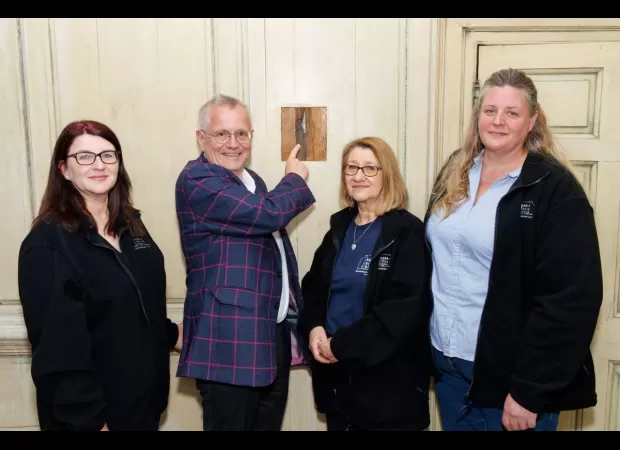Possible paraphrase: Is this bullet hole evidence of an attempted assassination of Bonnie Prince Charlie in Stirling?
Historians found a bullet hole at Bannockburn House, suggesting an assassination attempt on Bonnie Prince Charlie. The house has delicate plaster work and an ancient wooden paneling. Prince Charles Stuart stayed there in 1746.

In a fascinating turn of events, historians have recently uncovered a long-lost piece of evidence at Bannockburn House that may hold the key to an attempted assassination on Bonnie Prince Charlie. Amidst the grandeur and intricate design of the Grade A listed house, a musket ball hole has been discovered, sending shockwaves through the historical community.
This bullet hole, found in the delicate plaster work and ancient wooden panelling of the house, is believed to have been fired at Prince Charles Edward Stuart while he sought refuge at Bannockburn House in 1746. At the time, the prince was recovering from an illness and had taken shelter in a large bedroom on the first floor's west wing. This room was adorned with a stunning plaster frieze of mermaids and layers of old wooden panelling, making it a rather lavish place for the prince to rest.
But little did he know, danger lurked just outside his window. It is suspected that an assassin took aim and fired a shot through the glass, narrowly missing Bonnie Prince Charlie as he slept. The musket ball then lodged itself in the wall at the head of the bed, a chilling reminder of what could have been a tragic event.
For centuries, the existence of this musket ball hole remained a tantalising legend, passed down through generations and shrouded in mystery. But now, thanks to the efforts of dedicated volunteers and the crucial lead from David Jenkinson, whose aunt was once the housekeeper for the last owner, the hole has finally been found.
It was a moment of excitement and wonder for Catherine Bradley, the History Team Lead at Bannockburn House, as she opened the hidden panel and uncovered the musket ball hole. "I carefully lifted the panel and saw the splintered wood," she recalls. "I knew we had found something very special." The discovery was then authenticated by renowned Jacobite historian Professor Murray Pittock and Stirling Council archaeologist Dr Murray Cook, adding even more weight to its significance.
Dr Cook, who has visited the bedroom many times over the years, was moved by the experience of seeing the damage firsthand. "To touch the spot and feel the thrill down my spine was an incredible tangible experience," he says. "It's definitely worth visiting Bannockburn House for this alone."
Professor Pittock, author of numerous books on the Jacobite era, was also struck by the significance of this discovery. "I am pleased to endorse that Bannockburn House Trust has almost certainly discovered forensic evidence of an assassination attempt on Prince Charles in 1746," he says. "This not only sheds light on the events of the Rising, but also offers insight into the relationship between Charles and Clementina Walkinshaw, which resulted in the birth of his only child."
As we reflect on this incredible find, it's evident that Bannockburn House holds a wealth of history and secrets waiting to be uncovered. And with each new discovery, we are reminded of the rich and complex tapestry of Scotland's past. To learn more about this and other cultural stories, be sure to subscribe to Scottish Field and stay up to date on the latest issues.




